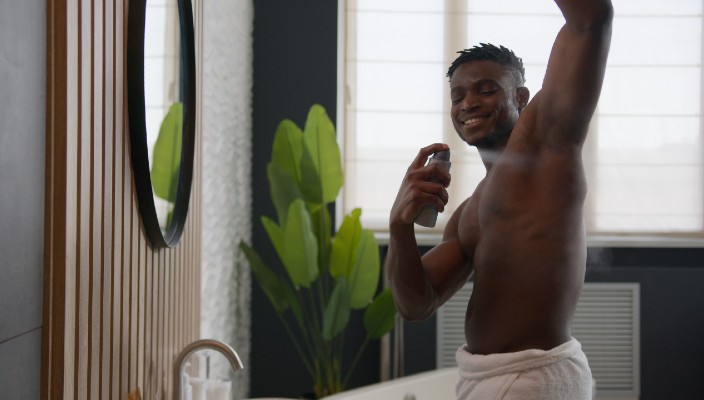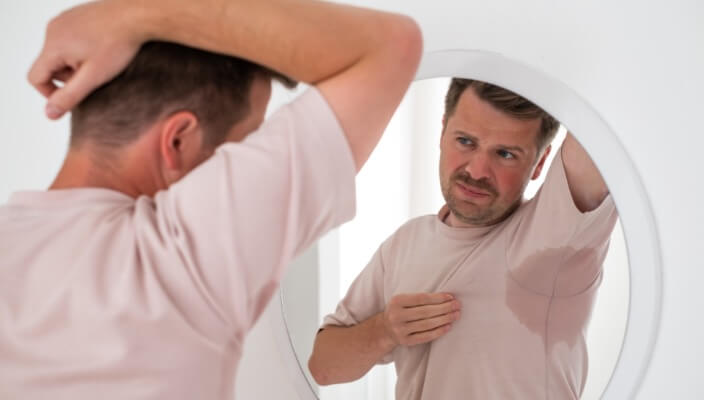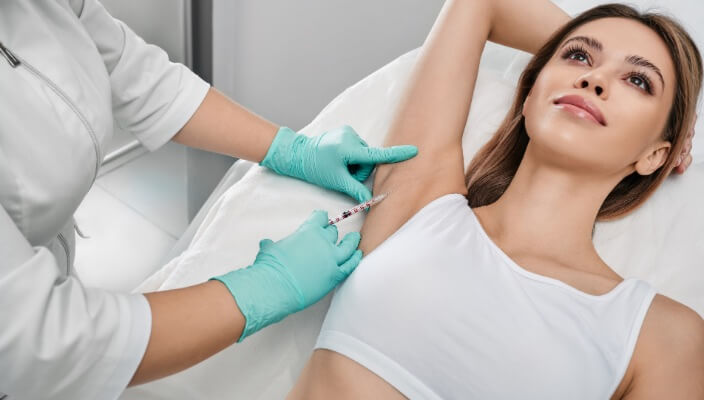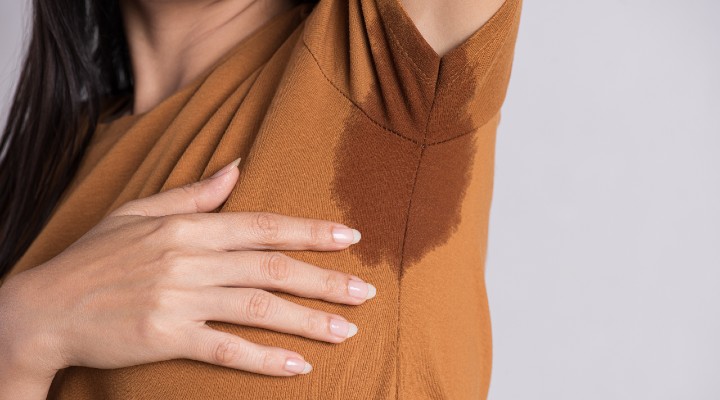Best Deodorants and Antiperspirants for Hyperhidrosis
What Is Hyperhidrosis?

Hyperhidrosis deodorant is ideal for those dealing with excessive sweating. While there are several ways to manage this condition, using the right hyperhidrosis deodorant or antiperspirant is often a key part of treatment.
From clinical-strength formulas to targeted hyperhidrosis antiperspirants, finding the best deodorant for hyperhidrosis starts with knowing what works. At Pinnacle Dermatology, we provide expert support to help you manage excessive sweating.
Hyperhidrosis is a medical condition that causes excessive sweating beyond what the body needs to regulate temperature. It can affect the underarms, hands, feet, face, or other areas, and often occurs even without heat or physical activity. While not dangerous, hyperhidrosis can be uncomfortable and affect daily quality of life. Common symptoms of hyperhidrosis include:
- Frequent, noticeable sweating that soaks through clothing
- Clammy or wet palms and soles
- Visible beads of sweat on the face or body, even at rest
- Skin irritation
- Difficulty gripping objects due to sweaty hands
- Emotional distress or embarrassment
What to Look for in a Hyperhidrosis Deodorant or Antiperspirant
Choosing the right product starts with understanding the difference between deodorants and antiperspirants. While deodorants help control odor, antiperspirants target sweat by blocking sweat glands. The best antiperspirants for hyperhidrosis often include aluminum-based ingredients for stronger protection, though some people prefer natural antiperspirant deodorants with gentler formulas.
OTC vs Prescription-Strength
Over-the-counter (OTC) antiperspirants are often the first step in managing hyperhidrosis and can be effective for mild to moderate sweating. Prescription-strength options contain higher concentrations of active ingredients, such as aluminum chloride, and are recommended for more severe cases.
Active Ingredients
When choosing a deodorant or antiperspirant for hyperhidrosis, the active ingredients play a crucial role in controlling sweat and odor. Look for formulas containing:
- Aluminum chloride: The most effective ingredient for blocking sweat glands and reducing excessive sweating.
- Aluminum zirconium compounds: Common in many clinical-strength antiperspirants, offering strong sweat control.
- Aluminum chlorohydrate: A gentler option often found in both prescription and OTC antiperspirants.
- Antimicrobial agents: Ingredients that help reduce odor-causing bacteria, such as triclosan.
- Natural alternatives: Some products use botanical extracts and mineral-based ingredients for those seeking a gentler, chemical-free approach, though they may be less effective for severe sweating.
Application and Formats
Hyperhidrosis deodorants and antiperspirants are available in various formats, including sticks, sprays, roll-ons, creams, and wipes. Choosing the right one depends on your preferences and where you're applying it.
Sticks and roll-ons are great for underarms, while wipes and creams offer more flexibility for hands, feet, or other targeted areas. Sprays can provide a quick and mess-free application.
Areas of the Body To Use Deodorant and Antiperspirant
While most people think of underarms first, hyperhidrosis can affect multiple areas of the body. Choosing the right format and applying products correctly can make a big difference in managing sweat.
Common areas to apply deodorant or antiperspirant include:
- Underarms
- Hands
- Feet
- Face and forehead
- Back or chest
How To Use Deodorant and Antiperspirant
Using hyperhidrosis antiperspirants correctly can enhance their effectiveness. Timing, frequency, and proper application all impact results, especially for those dealing with excessive sweating. In the sections below, we’ll cover the best times to apply and how often to use deodorants and antiperspirants for maximum effectiveness.
Best Time To Apply
The best time to apply hyperhidrosis antiperspirant is at night before bed. Sweat glands are less active while you sleep, giving the product time to absorb and form a protective barrier. This allows it to work more effectively the next day, even after showering in the morning.
How Frequently To Use Deodorants and Antiperspirants
For most people with hyperhidrosis, antiperspirants should be applied once daily, typically at night. Some clinical-strength formulas may be used every other day, depending on skin sensitivity and effectiveness. Deodorants, which target odor rather than sweat, can be reapplied as needed.
Other Options To Manage Hyperhidrosis
While antiperspirants and deodorants are a key part of managing hyperhidrosis, they aren’t the only solutions. Many people benefit from a combination of treatments tailored to their needs. In addition to topical products, certain lifestyle changes, medications, and in-office procedures can help control excessive sweating more effectively.
Lifestyle Tips
Simple lifestyle changes can assist in reducing sweat and maintaining comfort throughout the day. Here are a few helpful tips:
- Wear breathable, moisture-wicking clothing to help keep skin dry.
- Avoid spicy foods, caffeine, and alcohol, as they can trigger excessive sweating.
- Choose socks and shoes made of natural or breathable materials to help prevent foot sweating.
- Practice stress management techniques like deep breathing or meditation, especially if anxiety causes you to sweat.
- Shower regularly and dry thoroughly to reduce odor and irritation.
- Carry extra clothing or wipes if you experience breakthrough sweating during the day.
Medication
When topical treatments aren’t enough, medications can help manage hyperhidrosis by targeting sweat production from within. Oral anticholinergics are commonly prescribed to reduce overall sweating, though they may come with side effects. In some cases, antidepressants or beta-blockers may also be used if stress or anxiety contributes to symptoms.
Procedures
For more severe hyperhidrosis, medical procedures can provide effective and long-lasting relief. Common options include BOTOX® injections, which temporarily block the nerves that trigger sweating, and microwave therapy. In some cases, minimally invasive surgeries may be considered.
Find the Right Treatment With Pinnacle Dermatology
Managing hyperhidrosis starts with finding the solution that works best for your body, and you don’t have to do it alone. From clinical-strength antiperspirants to personalized treatment plans, there are many options available to help reduce symptoms and improve comfort. A Pinnacle Dermatology provider can help determine the right approach based on your needs. Schedule an appointment to take the first step toward lasting relief.
FAQs
If you sweat more than what’s typical, even when you are not hot, active, or stressed, you might have hyperhidrosis. Common signs include sweat soaking through clothing, dripping from your hands or face, or interfering with daily tasks. If this sounds familiar, a dermatologist can help confirm the diagnosis.
Overactive sweat glands can cause hyperhidrosis with no clear trigger (primary hyperhidrosis) or by an underlying health condition like thyroid issues, diabetes, or certain medications (secondary hyperhidrosis).
Hyperhidrosis is typically diagnosed through a physical exam, medical history, and questions about your sweating patterns. In some cases, additional tests may be used to rule out underlying conditions. At Pinnacle Dermatology, our providers can evaluate your symptoms and determine the type of hyperhidrosis you have.
Deodorants and antiperspirants for hyperhidrosis are widely available at drugstores, online retailers, and specialty skincare shops. A dermatologist may also recommend clinical-strength or prescription options.
Pinnacle Dermatology can help you find the right product and guide you toward trusted solutions. Be sure to browse our shop for dermatologist-recommended skincare products that support your treatment plan.
Not always. Many people start with an over-the-counter natural antiperspirant deodorant. However, if this isn't effective, a dermatologist can prescribe stronger clinical antiperspirants or other treatments tailored to your needs.
Yes, antiperspirants can help reduce excessive sweating. It works by blocking sweat ducts and limiting the amount of sweat that reaches the skin’s surface. The aluminum-based compounds in antiperspirants react with sweat to form temporary plugs in the sweat glands, limiting the amount of sweat you produce.

- General Dermatology
- Chronic Skin Conditions
Experience fast relief from hyperhidrosis with effective treatments tailored just for you. Learn about results and regain your confidence quickly today!
Read More
- General Dermatology
- Cosmetic Treatments
There’s nothing discrete about excessive armpit sweating. And with the obvious wet or sweat-stained clothing and worrisome body odor, it’s easy to feel uncomfortable, frustrated, and embarrassed.
Read More
- General Dermatology
While sweating, our body’s natural cooling system helps regulate our internal temperature, too much of a good thing can lead to serious skin issues.
Read More


